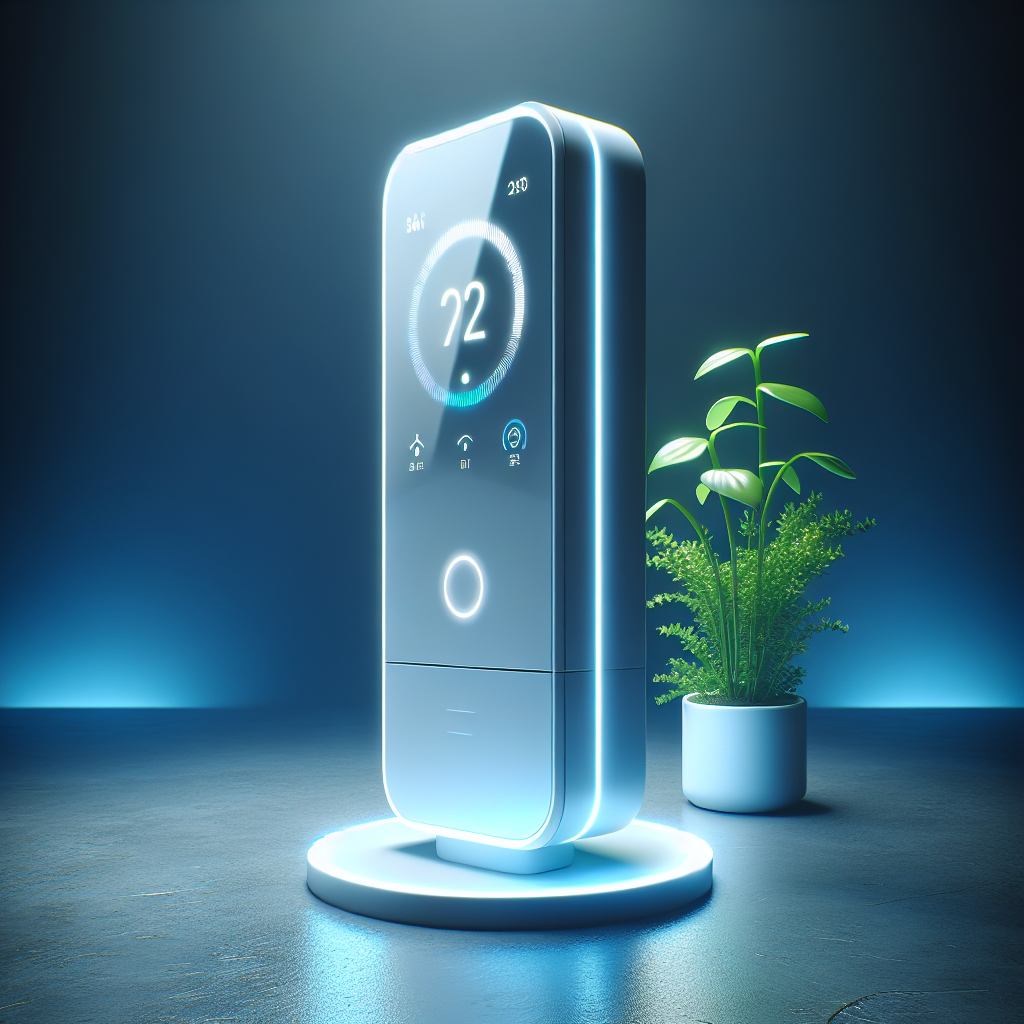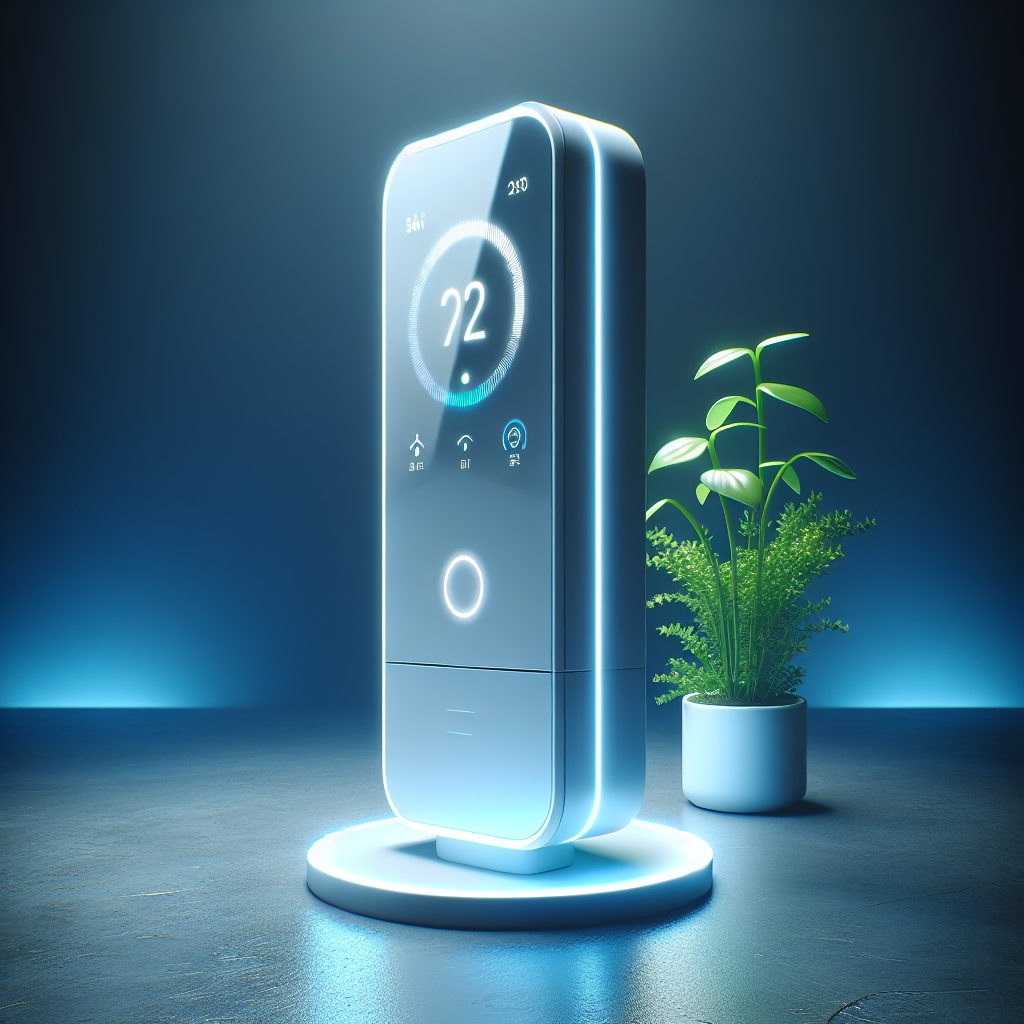Imagine being able to control the temperature of your home from anywhere with just a few taps on your smartphone. With smart thermostats, this futuristic concept becomes a reality. These innovative devices not only provide efficient climate control but also offer convenience and energy savings. By seamlessly integrating with your daily routine and adapting to your preferences, smart thermostats make it easier than ever to keep your home comfortable and your energy bills in check. Say goodbye to constantly adjusting the thermostat and hello to a smart, effortless way of maintaining the perfect indoor climate.

What are Smart Thermostats?
Definition
Smart thermostats are innovative devices that allow you to have efficient and convenient control over the climate in your home. Unlike traditional thermostats, which require manual adjustments, smart thermostats are designed to automatically regulate the temperature based on your preferences and schedule. With advanced features such as learning capabilities and integration with smart home systems, these devices offer a range of benefits for homeowners seeking to optimize energy efficiency, save on costs, and enhance convenience.
How They Work
Smart thermostats utilize various sensors and algorithms to monitor and adjust the temperature in your home. Equipped with Wi-Fi connectivity, they can be accessed and controlled remotely through a mobile app or a website. These thermostats gather data from factors like weather forecasts, time of day, occupancy patterns, and user input to create personalized heating and cooling schedules. By learning your preferences over time, smart thermostats can automatically adjust the temperature to ensure comfort while minimizing energy waste.
Advantages of Smart Thermostats
There are several advantages to using smart thermostats in your home. First and foremost, they offer enhanced energy efficiency compared to traditional thermostats. By intelligently adjusting the temperature based on occupancy and personalized schedules, smart thermostats can optimize energy usage and reduce waste. This not only helps the environment by lowering carbon emissions but also saves you money on your energy bills.
Another advantage of smart thermostats is the convenience and control they provide. With remote access through a mobile app, you can easily adjust the temperature from anywhere, ensuring your home is comfortable upon your arrival. Additionally, smart thermostats often have features such as integration with smart home systems, voice control compatibility, and data monitoring and analysis, which further enhance the convenience and customization options for homeowners.
Why Use a Smart Thermostat?
Energy Efficiency
One of the key reasons to use a smart thermostat is the significant improvement in energy efficiency it offers. Traditional thermostats typically have limited programmability, often requiring manual adjustments throughout the day. On the other hand, smart thermostats can learn your temperature preferences and create schedules that align with your routine. By automatically adjusting the temperature when you are away or asleep, they can reduce energy usage and ultimately lead to lower energy bills.
Cost Savings
Smart thermostats can lead to substantial cost savings over time. By optimizing your energy usage, these devices help to reduce wasted heating and cooling, resulting in lower energy bills. The ability to remotely control your thermostat also allows you to adjust the temperature when you are away from home, preventing unnecessary heating or cooling. Additionally, some utility companies offer incentives and rebates for installing and using smart thermostats, further reducing costs for homeowners.
Convenience and Control
With a smart thermostat, you have complete control over the climate in your home at your fingertips. The ability to remotely access and control your thermostat through a mobile app or website gives you the convenience of adjusting the temperature from anywhere. Imagine being able to warm up your home on a cold winter day before you even step foot inside. Whether you are at work, on vacation, or simply lounging on the couch, you can easily manage and customize your home’s temperature settings with ease.
Features of Smart Thermostats
Remote Control
One of the key features of smart thermostats is their remote control capabilities. Through a mobile app or website, you can easily access and adjust the temperature in your home from wherever you are. This not only provides convenience but also allows you to save energy by adjusting the temperature when you are away.
Learning capabilities
Smart thermostats are designed to learn your temperature preferences and daily routines over time. By analyzing data such as occupancy patterns and user input, they can create personalized heating and cooling schedules that align with your lifestyle. This learning capability eliminates the need for manual adjustments and ensures optimal comfort while maximizing energy efficiency.
Scheduling
Smart thermostats offer flexible scheduling options that allow you to set specific temperature settings for different times of the day or days of the week. For example, you can program your thermostat to lower the temperature while you are at work and raise it just before you return home. This feature ensures that you come home to a comfortable environment while minimizing energy waste.
Integration with Smart Home Systems
Many smart thermostats can integrate seamlessly with other smart home devices and systems. This integration enables enhanced control and automation options. For example, you can set your smart thermostat to adjust the temperature when you arm or disarm your security system or when your smart door lock detects that you’ve left or arrived home. This level of integration creates a smarter and more efficient home environment.
Data Monitoring and Analysis
Smart thermostats provide valuable data monitoring and analysis capabilities. By tracking and analyzing your energy usage patterns, they can provide insights and recommendations to help you optimize your energy consumption. The ability to view detailed energy reports and trends allows you to make informed decisions about your usage and identify areas where you can further improve energy efficiency.
Installation and Compatibility
Compatibility with HVAC Systems
Before purchasing a smart thermostat, it is important to ensure compatibility with your existing HVAC (heating, ventilation, and air conditioning) system. Smart thermostats are designed to work with a wide range of HVAC systems, including central heating and cooling, heat pumps, and even some multi-zone systems. However, it is always recommended to check the compatibility requirements of the specific model you are considering and consult with a professional if needed.
Installation Process
The installation process for smart thermostats can vary depending on the model and your existing HVAC system. Some smart thermostats are designed for easy DIY installation, while others may require professional installation, especially for more complex HVAC systems. It is important to carefully follow the manufacturer’s instructions and, if necessary, seek professional assistance to ensure a proper and safe installation.

Popular Smart Thermostat Models
Nest Learning Thermostat
The Nest Learning Thermostat is one of the most well-known and widely used smart thermostats. It features a sleek design and a user-friendly interface. The Nest Learning Thermostat utilizes advanced learning algorithms to create personalized schedules based on your temperature preferences and occupancy patterns. It also offers energy-saving features and integration with other Nest products and smart home systems.
Ecobee SmartThermostat
The Ecobee SmartThermostat is another popular choice in the smart thermostat market. It is equipped with a responsive touch display and supports voice control through popular virtual assistants such as Amazon Alexa and Google Assistant. The Ecobee SmartThermostat also includes occupancy sensors and can be integrated with other smart home devices for enhanced automation and energy efficiency.
Honeywell Lyric T5
The Honeywell Lyric T5 is a budget-friendly smart thermostat option that still offers excellent features and functionality. It provides remote control capabilities through a mobile app and can be integrated with popular smart home platforms such as Apple HomeKit and Amazon Alexa. The Honeywell Lyric T5 also includes geofencing technology, which allows the thermostat to automatically adjust the temperature based on your location.
Emerson Sensi Touch
The Emerson Sensi Touch is a versatile smart thermostat that is compatible with various HVAC system types, including single-stage, multi-stage, and heat pumps. It features a touchscreen display with easy-to-use controls and supports voice control through Amazon Alexa and Google Assistant. The Emerson Sensi Touch also offers flexible scheduling options and energy-saving features to help you maximize efficiency.
Considerations Before Buying a Smart Thermostat
Compatibility with Existing System
Before investing in a smart thermostat, it is crucial to ensure compatibility with your existing HVAC system. Check the specifications and compatibility requirements of the model you are considering to avoid any issues during installation or operation.
Wi-Fi Connectivity
Most smart thermostats rely on Wi-Fi connectivity for remote access and control. Ensure that your home has a strong and reliable Wi-Fi signal to ensure seamless operation of the smart thermostat.
Budget
Smart thermostats come in a range of prices, so it is important to determine your budget before making a purchase. Consider the features and capabilities you need and choose a model that fits within your budget while still meeting your requirements.
Installation Complexity
Consider the installation process and complexity of the smart thermostat you are considering. If you are comfortable with DIY installation, choose a model that offers easy installation instructions. However, if you have a more complex HVAC system or are unsure about the installation process, it is best to seek professional assistance.
Additional Features
Take into account any additional features or capabilities that may be important to you. For example, if you have other smart home devices, ensure that the smart thermostat is compatible with your existing system. Consider if you prefer voice control options or want advanced energy monitoring and reporting capabilities.
Tips for Using a Smart Thermostat
Understand Your Schedule
To maximize the benefits of a smart thermostat, take some time to understand your daily schedule. By knowing when you typically leave or return home, you can program your thermostat to adjust the temperature accordingly and minimize energy waste.
Optimize Temperature Settings
Experiment with different temperature settings to find the optimal comfort level without unnecessary heating or cooling. Small adjustments can make a significant difference in energy usage and cost savings.
Use Energy-Saving Features
Take advantage of the energy-saving features offered by your smart thermostat. Features such as occupancy sensors, adaptive recovery, and geofencing can help reduce energy consumption and lower your energy bills.
Regularly Update Firmware
Keep your smart thermostat’s firmware up to date. Manufacturers often release updates to improve performance, add new features, and address any security vulnerabilities. Regularly checking and installing firmware updates ensures your smart thermostat operates efficiently and securely.
Utilize Smart Home Integrations
If you have other smart home devices, explore the integration options available with your smart thermostat. Integration with devices such as smart lighting, security systems, and voice assistants can enhance automation, convenience, and energy efficiency.
Potential Energy Savings with Smart Thermostats
Studies and Research on Energy Savings
Numerous studies and research have shown the energy-saving potential of smart thermostats. According to a study conducted by the Lawrence Berkeley National Laboratory, smart thermostats can lead to energy savings of 10-12% on heating and 15% on cooling. Another study by the American Council for an Energy-Efficient Economy estimated that smart thermostats can save homeowners around 8-15% on annual heating and cooling costs.
Average Cost Savings
The exact cost savings vary depending on factors such as climate, home size, insulation, and individual usage patterns. However, on average, homeowners can expect to save around $100-$300 per year on energy bills by using a smart thermostat. These savings can add up significantly over time, making the investment in a smart thermostat worthwhile.
Environmental Impact
In addition to cost savings, smart thermostats also contribute to a reduced environmental impact. By optimizing energy usage and reducing carbon emissions, these devices help mitigate the effects of climate change. The collective impact of households adopting smart thermostats can contribute to a more sustainable and energy-efficient future.
Challenges and Limitations of Smart Thermostats
Compatibility Issues
One of the primary challenges of using a smart thermostat is compatibility with existing HVAC systems. While most smart thermostats are designed to be compatible with a variety of systems, there may still be cases where certain systems are not supported. It is important to thoroughly research and ensure compatibility before purchasing a smart thermostat.
Connectivity Problems
Reliable Wi-Fi connectivity is essential for the proper operation of smart thermostats. If your internet connection is unstable or experiences frequent outages, it may disrupt the remote control and automation features of your smart thermostat. Ensuring a stable Wi-Fi connection is crucial to avoid any connectivity problems.
Privacy and Data Security Concerns
Smart thermostats collect and analyze data about your energy usage and occupancy patterns. While this data is primarily used to optimize temperature settings and provide personalized experiences, privacy and data security concerns may arise. It is important to choose a reputable brand, read the privacy policy, and take necessary precautions to protect your personal information.
Conclusion
Smart thermostats offer a range of benefits, including energy efficiency, cost savings, and convenience. With their advanced features and capabilities, these devices provide homeowners with efficient control over their home’s climate. By considering compatibility, budget, and desired features, homeowners can select the right smart thermostat for their needs. With proper installation and usage, smart thermostats can help reduce energy consumption, lower energy bills, and contribute to a more sustainable future. So why wait? Upgrade to a smart thermostat today and experience efficient climate control at your fingertips.

